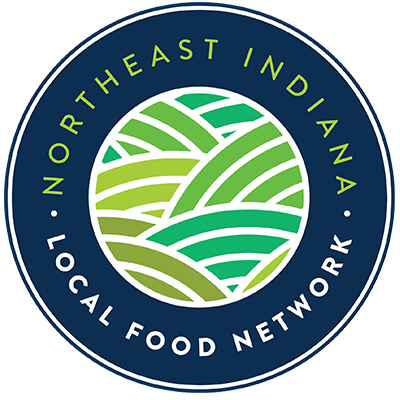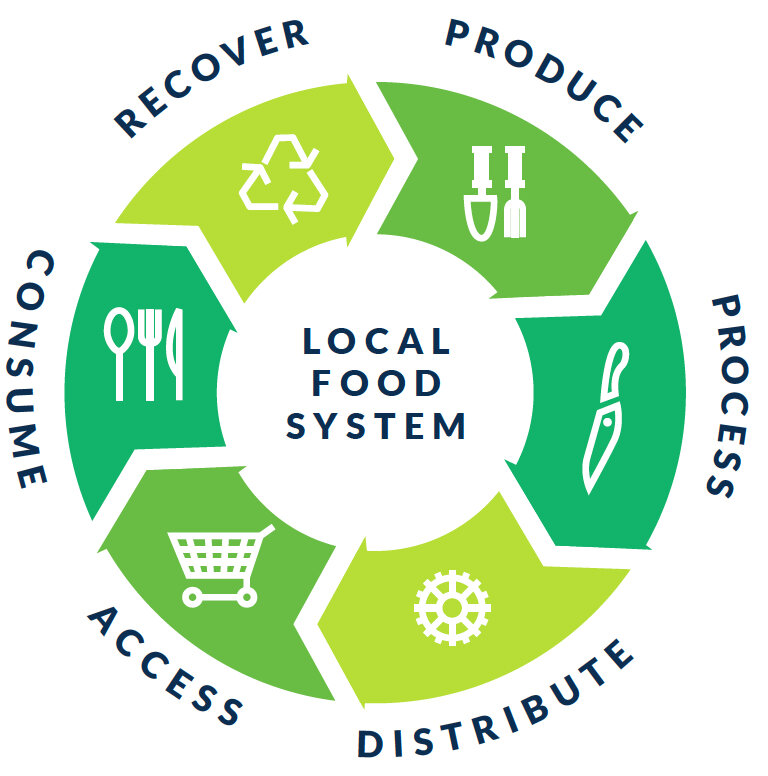Local Food Definitions
The Northeast Indiana Local Food Network believes it is important to understand the meaning of the words used to describe the local foods we eat and the agricultural practices used to produce them. We have compiled this list of definitions based on the food words and agricultural terms that are part of our Local Food Guide and used elsewhere on our website. We plan to add more terms to this list and clarify the existing terms, if needed, over time.
Certified Naturally Grown
Certified Naturally Grown (CNG) is a grassroots nonprofit program tailored for direct-market farmers producing food for their local communities. Like Certified Organic, CNG farms follow standards based on the National Organic Program, but it uses peer-to-peer inspections to certify compliance rather than certification by the USDA. CNG offers farmers a more affordable way to offer accountability to their customers and get credit for their organic practices.
Certified Organic
Organic certification verifies that farms and businesses comply with the USDA National Organic Program standards and allows businesses to sell, label, and represent their products as Organic. There are three distinct labeling categories for organic products:
100 Percent Organic - Agricultural products in the “100 percent organic” category contain only ingredients that are certified organic, including any processing aids.
Organic - Agricultural products in the “organic” category must contain no less than 95 percent of certified organic ingredients (excluding salt and water). The remaining five percent of ingredients must be organically produced, unless commercially unavailable or allowed on the National List.
“Made With” Organic - Multi-ingredient agricultural products in the “made with” category contain at least 70 percent certified organic ingredients (excluding salt and water). Any remaining agricultural products are not required to be organically produced, but must be produced without excluded methods – for example, genetic engineering.
Community Supported Agriculture (CSA)
At a farm that offers Community Supported Agriculture (CSA) shares, community members purchase a share of the farm’s production before each growing season. In doing so, these individuals, families and local businesses become members of the farm’s CSA. Members share both the risks and the benefits of the farm’s food production with the farmer. The farmer receives working capital in advance of the season and thus gains financial security. The CSA members receive a regular distribution of the farm’s harvest throughout the season. CSA models are adapted by some farms to incorporate value-added products and offer flexible shares and online purchasing.
Conventional
The term Conventional is used to describe the agricultural practices that have been used on most farms over the past 50+ years. Commercial pesticides, fertilizers and other soil amendments are likely used, as needed.
Food Hub
A Food Hub aggregates, distributes and markets local food products from a collection of farms and artisan food producers. The Food Hub offers small to mid-sized farms and artisan food producers the opportunity to access retail, wholesale and institutional markets that they may not have the capacity to do on their own. It also offers food buyers the opportunity to consolidate their local food orders and deliveries from one source.
Good Agricultural Practices (GAP)
Good Agricultural Practices (GAP) refers to ways of farming that minimize the risk of contamination of fruits and vegetables. GAP training and audits are not required to sell produce, but are part of a voluntary food safety program which some distributors and wholesale buyers of farm produce require.
Genetically Modified Organism (GMO)
A GMO, or genetically modified organism, is a plant, animal or other organism whose DNA has been modified using genetic engineering. A gene is inserted into the DNA of a single cell, then as the cell divides, that gene will be in every cell. This is done to give the plant or animal the performance characteristics desired by the producer such as higher yields, accelerated growth, disease resistance or longer storage life. This genetic modification creates combinations of plant, animal, bacterial and virus genes that do not occur in nature or through traditional crossbreeding methods. A significant percentage of food crops such as corn, soybeans, canola, sugar beets and potatoes are currently genetically modified.
GMO-free or Non GMO
A plant or animal or other organism whose DNA has developed through natural selection or traditional crossbreeding methods and has not been altered using genetic engineering. This term also applies to products from animals who have not been fed any genetically modified foods. Hence GMO-free eggs or meats come from animals that were fed a diet containing no GMO ingredients.
Grass-fed
Animals, primarily cattle and cows, are defined as Grass-fed if they are mainly raised and fed grass on pasture during most of the year, and fed stored hay and grass silage indoors (if needed) over the winter. Cattle which are Grass-finished maintain this grass-only diet throughout their lives. Cattle which are Grain-finished are fed a grain-based diet during their final months prior to processing. In this Local Food Guide, the term Grass-fed is used to describe products from animals which are Grass-finished. The nutrient value and flavor of beef and dairy products varies depending on what the animal eats.
Integrated Pest Management (IPM)
Integrated Pest Management (IPM) is a science-based approach to solving pest problems by applying knowledge about pests to prevent them from damaging crops or harming animals. Using IPM methods means responding to pest problems in a way that minimizes overall economic, health and environmental risks. Application of pesticides is always the last resort.
Local
There is no standard definition of “local”. Each business, organization or person can define the term as it makes sense to them. Our organization and this website defines “local’ as coming from the 11 counties of Northeast Indiana. See “What is local food?” .
Local Food System
The term local food system refers to all of the activities associated with producing, processing, distributing, accessing and consuming food and recovering food waste within a specific region. The local food produced on Northeast Indiana farms that is also consumed in Northeast Indiana is part of a localized food system that connects our land to our tables. The businesses and organizations that are a part of this system are featured in our Local Food Guide. See “What is local food?” .
Low Spray
Pesticides and other chemicals are used sparingly and only when absolutely needed.
Organic Practices, not Certified
Several of the farms in our Local Food Guide use organic practices to grow the food they produce, but are not Certified Organic. The third party verification obtained through USDA organic certification is very valuable to some consumers as they choose what products to buy. Some consumers seek foods produced using organic practices, but make their food choices based more on their trust in the farmer and the farm’s transparency in their growing practices than on organic certification. Based on the agricultural practices they use and their relationship with the consumers who buy their products, each farm decides whether it makes financial and business sense for them to pursue organic certification or any other certification that offers accountability to their customers.
Pasture raised
This term does not have a legal definition, therefore the term can be interpreted in different ways by farmers, marketers and consumers. In general, animals (cattle, dairy cows, pigs, sheep, goats and poultry) are described as pasture raised if the animals lived on open pastures or fields for all or part of it’s life, without confinement as much as the seasons allow. This term applies to where and how the animal lives, not necessarily what the animal eats. Ruminant animals who eat grasses have the opportunity to eat the grasses while on pasture in season, or they can receive a diet supplemented with only hay or supplemented with grains, as well. Other animals who live on pasture are provided access to grains to eat in addition to eating the plants and insects from the pasture.
Regenerative Agriculture
Regenerative Agriculture describes farming and grazing practices that build soils and increase soil fertility, biodiversity and health. These practices build crop resilience and produce foods with greater nutrient density. The soils that are generated have an increased capacity to hold water which reduces flooding and erosion. These healthy soils also sequester carbon more effectively to help reverse climate change.
Seasonal
The term Seasonal refers to the traditional growing season on a farm or of a particular agricultural product.
Season Extension
Season Extension refers to the use of farming techniques often using structures such as greenhouses, high tunnels, hoop houses or caterpillar tunnels to extend the traditional growing season. These structures and growing techniques provide farmers the ability to produce fruits, vegetables and other crops earlier in the Spring, later into the Fall, or in some cases year-round.
Local Food Definition Resources
For those seeking more information, here are a list of some of the resources used to compile these local food definitions.


